Shaheed Bhai Jeevan Singh Jee
By Manvir Singh Khalsa
A GLIMPSE AT THE LIFE OF SHAHEED BHAI JEEVAN SINGH JEE
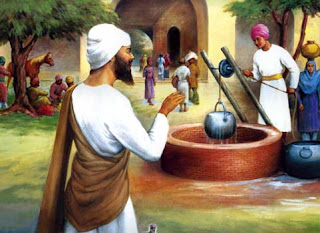
Background
Bhai Jaita jee was born on 30th November 1649 to Bibi Kanno jee and Bhai Sada Chand jee. When he was born he was named 'Jag Chand', and 'Jagu' or 'Jota' for short. He and his younger brother Bhag Chand, also Called Bhagu, were the disciples of the seventh Nanak, Guru Har Rai Sahib jee. They lived at Kiratpur Sahib where Guru Sahib was staying, however later his family and him moved to the village Jhandaa Raamdaas where they stayed with Bhai Gurditta jee (1625-1675), the great great-grandson of Baba Buddha jee.
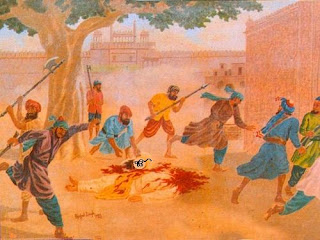
Fearless Seva (Selfless Service)
In 1675, Kashmiri Pandits came to seek the Ninth Nanak, Guru Teg Bahadar Sahib jee’s help to save humanity and defend the right of living in peace without oppression, as Aurangzeb was cruelly and forcefully converting large numbers of people to Islam through the sword and making the common man's life a living hell. Guru Teg Bahadar Sahib jee responding to the cries of society and sacrificed his head alongside his 3 disciples in Delhi to defend the human rights and right of free religious expression for humanity.
In total 5 Sikhs had accompanied Guru Sahib to Delhi. One of these were Bhai Gurditta jee, who was detained in Delhi following the arrest of Guru Tegh Bahadar Sahib jee. Bhai Jaita jee was sent by the family to bring news of Bhai Gurditta jee. He was in Delhi when Guru Sahib was beheaded in a public on 11th November 1675. No one dared to come forward to claim the dead physical body of the Guru or the head fearing the army's aggression. However, Bhai Jaita jee was successful in evading the guards and escaping with the severed head to Sri Anandpur Sahib where he was received by the Tenth Nanak, Guru Gobind Singh Sahib jee.
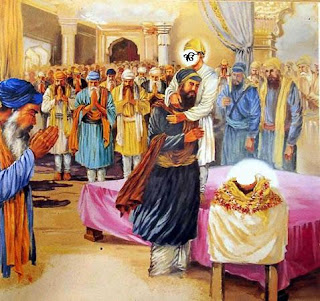
Honour Given to Bhai Jaita jee
Guru Gobind Singh Sahib jee honoured Bhai Jaita jee when he arrived to Sri Anandpur Sahib with the head of Guru Sahib. Socially, Bhai Jaita jee belonged to the background of 'Ranghars' (scavengers). The Ranghar caste were the people who had one of their ancestors born out of mixed parentage of a Hindu and Muslim couple, and thus were outcastes out of Hindu religion. Guru Gobind Singh Sahib jee, raised Bhai Jaita jee by embracing him in front of the Sikh Sangat and describing him as 'Ranghrettaa Guru Ka Betaa' (the young man of the Ranghar caste is the Guru's own son).
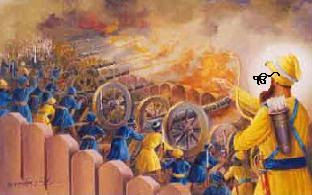
Seva of Dasam Pita (Tenth Father)
Bhai Jaita jee thereafter lived at Sri Anandpur Sahib and became the first Nagarchee (beater of war drum) when the Guru set up the Ranjeet Nagaara (The battle war drum of victory). In 1691 he was married to Bibi Raj Kaur, daughter of Bhai Sujan Singh of the village of Riaar, near Amritsar. They had four sons. Bhai Jaita along with his family became Amritdhari on the Vaisaakhi of 1699 and became Bhai Jeevan Singh jee from there on. He became famous as a marksman and trained the two elder Sahibzaadey (sons) of Guru Gobind Singh Sahib jee in the art of warfare. Bhai Jeevan Singh jee took part in all of Guru Sahib's battles against the attacking Hindu Hill Rajas and the Mughal imperial forces.
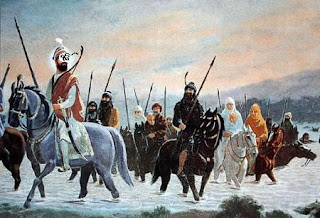
Shaheedi (Martyrdom)
Bhai Jeevan Singh jee fell a Shaheed (martyr) in the battle of Chamkaur Sahib on 7th December 1705. A burj (watch tower) called 'Gurdwara Shaheed Burj Bhai Jeevan Singh' stands on the site as a monument to Bhai Sahib's memory. According to Bhatt Vahees (a historical text), Bhai Jeevan Singh jee was killed in a rear-guard action while protecting Guru Sahib, his family and the beloved Sikh Sangat on the bank of the River Sarsaa.
When the the blood of martyrs spills, the picture of a nation changes.
Shaheedaa Nu Lakh Lakh Parnaam
Source:Manvir Singh Khalsa ਮਨਵੀਰ ਸਿੰਘ ਖਾਲਸਾ
----------------------------------------
----------------------------------------
----------------------------------------
----------------------------------------
By Manvir Singh Khalsa
21st December marks the Shaheedi Diwas (martyrdom day) of Shaheed Bhai Jeevan Singh jee. Bhai Jeevan Singh was born in 1649, who's name was Bhai Jaita jee before he received the divine Amrit from the hands of Dasam Pitaa Guru Gobind Singh Sahib jee in 1699. This post is in commemoration to Shaheed Bhai Jeevan jee who lived as a true Saint-Warrior.
A GLIMPSE AT THE LIFE OF SHAHEED BHAI JEEVAN SINGH JEE

Background
Bhai Jaita jee was born on 30th November 1649 to Bibi Kanno jee and Bhai Sada Chand jee. When he was born he was named 'Jag Chand', and 'Jagu' or 'Jota' for short. He and his younger brother Bhag Chand, also Called Bhagu, were the disciples of the seventh Nanak, Guru Har Rai Sahib jee. They lived at Kiratpur Sahib where Guru Sahib was staying, however later his family and him moved to the village Jhandaa Raamdaas where they stayed with Bhai Gurditta jee (1625-1675), the great great-grandson of Baba Buddha jee.

Fearless Seva (Selfless Service)
In 1675, Kashmiri Pandits came to seek the Ninth Nanak, Guru Teg Bahadar Sahib jee’s help to save humanity and defend the right of living in peace without oppression, as Aurangzeb was cruelly and forcefully converting large numbers of people to Islam through the sword and making the common man's life a living hell. Guru Teg Bahadar Sahib jee responding to the cries of society and sacrificed his head alongside his 3 disciples in Delhi to defend the human rights and right of free religious expression for humanity.
In total 5 Sikhs had accompanied Guru Sahib to Delhi. One of these were Bhai Gurditta jee, who was detained in Delhi following the arrest of Guru Tegh Bahadar Sahib jee. Bhai Jaita jee was sent by the family to bring news of Bhai Gurditta jee. He was in Delhi when Guru Sahib was beheaded in a public on 11th November 1675. No one dared to come forward to claim the dead physical body of the Guru or the head fearing the army's aggression. However, Bhai Jaita jee was successful in evading the guards and escaping with the severed head to Sri Anandpur Sahib where he was received by the Tenth Nanak, Guru Gobind Singh Sahib jee.

Honour Given to Bhai Jaita jee
Guru Gobind Singh Sahib jee honoured Bhai Jaita jee when he arrived to Sri Anandpur Sahib with the head of Guru Sahib. Socially, Bhai Jaita jee belonged to the background of 'Ranghars' (scavengers). The Ranghar caste were the people who had one of their ancestors born out of mixed parentage of a Hindu and Muslim couple, and thus were outcastes out of Hindu religion. Guru Gobind Singh Sahib jee, raised Bhai Jaita jee by embracing him in front of the Sikh Sangat and describing him as 'Ranghrettaa Guru Ka Betaa' (the young man of the Ranghar caste is the Guru's own son).

Seva of Dasam Pita (Tenth Father)
Bhai Jaita jee thereafter lived at Sri Anandpur Sahib and became the first Nagarchee (beater of war drum) when the Guru set up the Ranjeet Nagaara (The battle war drum of victory). In 1691 he was married to Bibi Raj Kaur, daughter of Bhai Sujan Singh of the village of Riaar, near Amritsar. They had four sons. Bhai Jaita along with his family became Amritdhari on the Vaisaakhi of 1699 and became Bhai Jeevan Singh jee from there on. He became famous as a marksman and trained the two elder Sahibzaadey (sons) of Guru Gobind Singh Sahib jee in the art of warfare. Bhai Jeevan Singh jee took part in all of Guru Sahib's battles against the attacking Hindu Hill Rajas and the Mughal imperial forces.

Shaheedi (Martyrdom)
Bhai Jeevan Singh jee fell a Shaheed (martyr) in the battle of Chamkaur Sahib on 7th December 1705. A burj (watch tower) called 'Gurdwara Shaheed Burj Bhai Jeevan Singh' stands on the site as a monument to Bhai Sahib's memory. According to Bhatt Vahees (a historical text), Bhai Jeevan Singh jee was killed in a rear-guard action while protecting Guru Sahib, his family and the beloved Sikh Sangat on the bank of the River Sarsaa.
ਜਦ ਡੁੱਲ੍ਹਦਾ ਖ਼ੂਨ ਸ਼ਹੀਦਾਂ ਦਾ, ਤਸਵੀਰ ਬਦਲਦੀ ਕੌਮਾਂ ਦੀ।
jad dulHdaa khoon shaheedaa(n) daa, tasveer badaldee khaumaa(n) dee.
When the the blood of martyrs spills, the picture of a nation changes.
Shaheedaa Nu Lakh Lakh Parnaam
Source:Manvir Singh Khalsa ਮਨਵੀਰ ਸਿੰਘ ਖਾਲਸਾ
----------------------------------------
----------------------------------------
----------------------------------------
----------------------------------------




